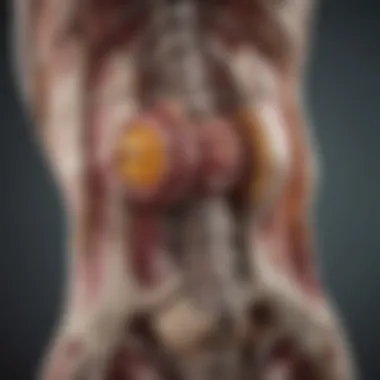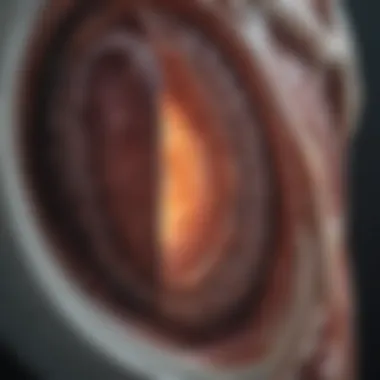Lumbar Hemangioma: A Detailed Exploration


Intro
Lumbar hemangiomas are benign tumors that primarily occur in the lumbar spine. These vascular lesions are often asymptomatic and discovered incidentally during imaging for other conditions. Despite their benign nature, understanding lumbar hemangiomas is essential for health professionals, researchers, and students, as they can sometimes lead to complications.
In this article, we will explore various aspects of lumbar hemangiomas, including their etiology, diagnostic approaches, potential symptoms, and treatment options. We will also dive into recent developments in research that shed light on these unique tumors.
This exploration aims to provide comprehensive insights into lumbar hemangiomas and their implications, serving as an informative resource for those interested in spinal health.
Intro to Lumbar Hemangiomas
Understanding lumbar hemangiomas is crucial in the field of spinal health. These benign vascular tumors, predominantly located in the lumbar spine, can have significant implications on an individual's well-being. A comprehensive examination of lumbar hemangiomas enhances knowledge for medical professionals, students, and researchers alike. The topic covers various aspects such as incidence, diagnosis, symptoms, and treatment options.
Definition and Overview
Lumbar hemangiomas are benign tumors that arise from the blood vessels in the vertebrae, specifically in the lumbar region of the spine. They are typically asymptomatic and are often discovered incidentally during imaging studies for unrelated conditions. The composition of these tumors involves a complex network of blood vessels that can vary in size and density.
These tumors exist in different forms, predominantly classified as capillary or cavernous hemangiomas. The capillary type consists of small blood vessels, while the cavernous type involves larger vascular channels. Both types can contribute to structural changes in the vertebrae but rarely cause significant health issues.
Epidemiology
The epidemiology of lumbar hemangiomas shows a diverse landscape. These tumors are relatively common, with studies indicating that they are found in approximately 1% to 3% of the general population. Interestingly, their prevalence increases with age, particularly in individuals over 40 years old.
Lumbar hemangiomas are identified more frequently in women than in men, with a male-to-female ratio of about 1:2. Despite their benign nature, the location and size of these tumors can influence medical management. Most lumbar hemangiomas remain dormant, but a small percentage may grow, leading to complications that warrant further examination and potentially treatment.
"Understanding the epidemiology is essential for early detection and appropriate management of lumbar hemangiomas."
Insights into the demographics and prevalence of lumbar hemangiomas are essential for healthcare providers. These insights facilitate improved awareness and inform clinical guidelines for diagnosis and intervention.
Pathophysiology of Lumbar Hemangiomas
Understanding the pathophysiology of lumbar hemangiomas is critical for comprehending their growth, behavior, and the implications they have on patient health. These benign tumors are vascular malformations comprising of endothelial cells forming blood vessels. The nature of these cells and their arrangement significantly impact how these tumors develop and respond to various stimuli. It is essential to explore the types of hemangiomas, their characteristics, and the mechanisms behind their formation and development.
Types of Hemangiomas
Capillary Hemangiomas
Capillary hemangiomas are characterized by small, closely packed capillary vessels. This type commonly presents as a soft mass, usually seen in the lumbar region. The primary significance of capillary hemangiomas lies in their benign nature. Unlike other types of tumors, they tend not to invade surrounding tissues, which often makes them less concerning. Their unique feature is their tendency to undergo spontaneous regression, especially in children. This provides a significant advantage in terms of management, allowing many cases to be monitored rather than aggressively treated. However, they may still cause issues due to their location, potentially leading to discomfort or cosmetic concerns.
Cavernous Hemangiomas
Cavernous hemangiomas, in contrast, consist of larger blood vessels and are generally deeper and more extensive than capillary forms. They present as soft blue masses that can be palpable. One of the key characteristics is their higher vascularity, making them more likely to cause complications such as bleeding or neurological symptoms if they compress nearby nerve roots. In terms of their overall importance for this article, understanding cavernous hemangiomas offers insight into the more severe complications associated with lumbar hemangiomas. Despite their benign classification, their size and vascularity can make them more challenging to manage, necessitating careful monitoring and possibly intervention.
Developmental Mechanisms
The developmental mechanisms of lumbar hemangiomas remain an area of ongoing research. Generally, these tumors arise due to dysregulation during embryological development. Factors such as genetic predisposition and environmental triggers might play roles in their formation. By investigating these mechanisms, researchers can develop a clearer picture of why some individuals develop these tumors while others do not. Understanding these underlying processes is crucial for future prevention strategies and therapeutic approaches.
"The pathophysiology of lumbar hemangiomas provides insights into their development, monitoring, and management, enhancing healthcare providers' ability to treat patients effectively."
In summary, elucidating the pathophysiology of lumbar hemangiomas—by categorizing types and understanding developmental mechanisms—serves as a foundation. This knowledge aids in clinical decision-making, patient education, and further research efforts.
This exploration into the pathophysiological aspects enriches the narrative of lumbar hemangiomas, leading toward better health outcomes.
Clinical Presentation


Understanding the clinical presentation of lumbar hemangiomas is essential for both diagnosis and management. Recognizing the symptoms and potential complications helps healthcare professionals to decide on the best course of action. The clinical signs can vary significantly among individuals, making accurate reporting crucial for effective treatment.
Common Symptoms
Back Pain
Back pain is one of the most prevalent symptoms associated with lumbar hemangiomas. Patients often report this discomfort as a dull ache or sharp pain localized in the lower back. This symptom may be significant because it affects the quality of life. Many healthcare providers prioritize back pain as a key indicator when assessing lumbar conditions.
A unique feature of back pain in lumbar hemangiomas is that it can occur without any evident structural damage in the spine. This makes it a concern since patients might underestimate the severity. Accurate evaluation of back pain can guide clinicians in determining whether imaging studies are necessary.
- Key characteristic: Persistent and localized discomfort.
- Advantages: Early identification may lead to timely intervention.
- Disadvantages: Not all patients with lumbar hemangiomas experience back pain, which can complicate the diagnostic process.
Neurologic Symptoms
Neurologic symptoms, such as numbness or weakness in the legs, can also be indicative of lumbar hemangiomas. These symptoms arise when the tumor exerts pressure on surrounding nerves or the spinal cord. The presence of neurologic symptoms can change the urgency of clinical intervention.
A critical aspect of neurologic symptoms is that they may reflect more serious underlying issues, such as nerve compression. Recognizing these signs allows for quicker diagnostic imaging. This makes neurologic symptoms particularly relevant to this article.
- Key characteristic: May signify nerve involvement.
- Advantages: Identifying neurologic symptoms quickly can lead to rapid treatment decisions.
- Disadvantages: They may be mistaken for other conditions, leading to misdiagnosis.
Potential Complications
In discussing lumbar hemangiomas, one must consider potential complications that can arise, which include fractures and cord compression. Understanding these complications is key for both patients and clinicians.
Fractures
Fractures in the context of lumbar hemangiomas often occur due to weakened vertebrae caused by the tumor. This weakness can lead to vertebral collapse, especially under physical stress or trauma. Such fractures may lead to acute pain and disability.
The emphasis on fractures lies in their direct impact on a patient’s mobility and overall health. The relationship between hemangiomas and fractures is notable, making it a relevant consideration in the clinical landscape.
- Key characteristic: Increased risk of vertebral fractures.
- Advantages: Knowing the fracture potential may lead to proactive monitoring strategies.
- Disadvantages: Not all hemangiomas predictably lead to fractures, complicating patient management strategies.
Cord Compression
Cord compression is a more serious complication arising from lumbar hemangiomas. This occurs when the tumor expands and presses against the spinal cord, leading to severe symptoms. Patients may experience significant neurologic compromise.
The danger associated with cord compression stresses the importance of timely diagnosis. It warrants immediate intervention in order to prevent potential long-term damage.
- Key characteristic: Can cause severe neurologic deficits.
- Advantages: Awareness can lead to urgent imaging and treatment protocols.
- Disadvantages: Symptoms can sometimes be subtle, making early detection challenging.
"Recognition of clinical presentation fascinates medical professionals and aids in determining the appropriate level of intervention needed for lumbar hemangiomas."
Understanding the clinical presentation of lumbar hemangiomas helps frame the rest of the article, revealing essential details that underpin effective diagnosis and treatment.
Diagnostic Approaches
The diagnostic approaches to lumbar hemangiomas are crucial for accurate identification and management. A proper diagnosis can help distinguish lumbar hemangiomas from other spinal lesions. Early detection often leads to better treatment options and reduces the risk of complications. Using the right imaging modalities and diagnostic tools significantly aids healthcare professionals in developing comprehensive management plans.
Imaging Techniques
Magnetic Resonance Imaging (MRI)
Magnetic Resonance Imaging (MRI) stands out as a primary imaging tool for lumbar hemangiomas. The key characteristic of MRI is its high-resolution images of soft tissues, which helps in visualizing vascular tumors with clarity. This imaging technique allows the differentiation of hemangiomas from other more aggressive tumors.
The unique feature of MRI is its ability to assess the extent of the hemangioma without exposing patients to ionizing radiation. This makes it a beneficial choice in cases where repeated imaging may be necessary. The advantages of MRI include exceptional contrast resolution and the capability to provide multiple imaging planes. However, it has some disadvantages such as higher costs and longer scanning times compared to other modalities.


Computed Tomography (CT)
Computed Tomography (CT) is another important imaging technique for diagnosing lumbar hemangiomas. The key characteristic of CT is its rapid acquisition of images, which is useful in emergency settings. It provides detailed information regarding the bony structures of the spine and can indicate any bone involvement caused by the hemangioma.
A unique feature of CT imaging is its effectiveness in quickly identifying complications like fractures or calcifications within the hemangioma. The advantages include its widespread availability and speed; however, it does involve exposure to radiation. Thus, careful consideration of the benefits and risks is always important when choosing this imaging method.
Histopathological Analysis
Histopathological Analysis plays a critical role in confirming the diagnosis of lumbar hemangiomas. This process involves taking a biopsy of the tumor and examining the tissue under a microscope. The analysis can help confirm the benign nature of the tumor and provides insight into its cellular characteristics. This is particularly important when distinguishing a hemangioma from more aggressive entities that may mimic its presentation. Histopathological findings often include a predominance of vascular channels and the presence of specific cellular elements. Effective communication of these findings can impact treatment decisions and follow-up strategies.
Treatment Options
When addressing lumbar hemangiomas, understanding the treatment options is vital. Different strategies exist, each tailored to the specifics of the hemangioma and the patient’s overall health. The choice of treatment can significantly impact the patient's quality of life, symptoms, and long-term outcomes. This section will explore three primary treatment options: observation and monitoring, surgical interventions, and radiation therapy.
Observation and Monitoring
In many cases, lumbar hemangiomas are discovered incidentally during imaging exams for unrelated issues. When these tumors are small and asymptomatic, observation and monitoring may be the best approach. This strategy typically involves regular follow-up imaging to track any changes in the size or characteristics of the hemangioma.
The primary benefit of this approach is the avoidance of unnecessary interventions, especially since many hemangiomas are benign and may not cause any significant health issues over time. However, close monitoring is essential to ensure timely action if symptoms arise or if the hemangioma increases in size.
Surgical Interventions
Decompression Surgery
Decompression surgery is a significant procedure aimed at relieving pressure on the spinal cord caused by a hemangioma. This surgical option is recommended when the hemangioma leads to intractable pain or neurological symptoms. The key characteristic of decompression surgery is that it directly addresses the source of the problem by removing bony elements or tumor tissue pressing on critical structures.
A beneficial aspect of this approach is its capability to provide rapid relief of symptoms. Patients often report improved functioning and pain levels after undergoing this procedure. However, the disadvantages include potential complications, such as infection or the need for further surgery. This surgical method requires careful consideration and discussion with a healthcare professional to assess risks and outcomes.
Vertebroplasty
Vertebroplasty involves injecting a special cement-like substance into the vertebra to stabilize it and reduce pain associated with lumbar hemangiomas. This procedure is particularly useful in cases where hemangiomas cause vertebral compression fractures. The key characteristic of vertebroplasty is its minimally invasive nature. It is often performed using local anesthesia, allowing for a quicker recovery time compared to more invasive surgeries.
The unique feature of vertebroplasty is its dual aim: to provide pain relief and restore stability to the affected vertebra. Many patients find significant relief following the procedure, often allowing them to return to normal activities more swiftly. Nonetheless, as with any procedure, there are risks, including cement leakage or failure to relieve pain entirely.
Radiation Therapy
Radiation therapy is another treatment avenue for lumbar hemangiomas, particularly in cases that are symptomatic and where other treatment options are less viable. This technique employs targeted radiation aimed at reducing the size of the tumor and alleviating symptoms. The benefits of radiation therapy include a non-invasive nature and the ability to treat tumors without the risks associated with surgical procedures.
However, one must consider the long-term implications, as radiation could potentially lead to future complications, including damage to nearby healthy tissues. A thorough discussion with a healthcare provider can help determine if this option is appropriate based on the specific circumstances of the hemangioma.
"Understanding the diverse treatment options available is essential for effective management of lumbar hemangiomas, ensuring tailored approaches that prioritize patient well-being."
In summary, treatment options for lumbar hemangiomas vary widely, from observation and monitoring for asymptomatic cases to more invasive surgical procedures and radiation therapy for complicated scenarios. Each of these interventions has its advantages and disadvantages that must be carefully weighed against the patient’s condition and overall health.
Natural History and Prognosis
Understanding the natural history and prognosis of lumbar hemangiomas is crucial for multiple reasons. Firstly, it helps clinicians make informed decisions about the management strategies for patients. Secondly, it provides insights into how these benign tumors can affect an individual over time and outlines the possible outcomes based on their characteristics. A comprehensive look at natural history aids in clarifying the path a lumbar hemangioma might take from discovery to its potential long-term ramifications.
Long-Term Outcomes
Lumbar hemangiomas are generally considered benign vascular lesions, and many individuals who have them remain asymptomatic throughout their lives. However, long-term outcomes can vary significantly based on the type, location, and size of the hemangioma.
- Asymptomatic Cases: In many instances, lumbar hemangiomas are discovered incidentally during imaging for other conditions. Patients in these categories often experience no pain or other symptoms as they age, suggesting a favorable long-term outcome.
- Symptomatic Cases: For some patients, symptomatic presentations can emerge. In these cases, the likelihood of experiencing complications such as vertebral fractures or spinal canal compression tends to increase. The long-term outlook for these individuals may hinge on timely intervention and effective management of the symptoms.
- Necessity of Regular Monitoring: Individuals diagnosed with larger or symptomatic hemangiomas may require periodic imaging to monitor changes over time. This approach can ensure any emergent issues are identified sooner rather than later, contributing positively to the long-term prognosis.
Factors Influencing Prognosis


Several factors can influence the prognosis of lumbar hemangiomas. Understanding these can be key for clinicians and researchers alike.
- Type of Hemangioma:
- Size and Location:
- Patient's Overall Health: An individual’s overall health status plays a role in recovery and outcome. A patient with pre-existing health issues may experience a more complicated management course compared to a healthier patient.
- Response to Treatment: How well a patient responds to interventions, whether surgical or non-surgical, greatly determines their long-term outcomes.
- Capillary Hemangiomas: Generally less aggressive and associated with a better prognosis. They are less likely to cause significant problems.
- Cavernous Hemangiomas: These may have a higher risk of complications. Early detection and management are essential for a better prognosis.
- Larger hemangiomas pose a greater risk of complications such as fractures or neurological issues. Their location within the spinal column may affect their potential to compress adjacent structures, influencing the overall health of the patient.
In summary, the natural history and prognosis of lumbar hemangiomas is a field rich with variants and nuances. Understanding the lifetime trajectory of these tumors sets a foundation for better clinical practices and research directions.
Research and Advances
Research into lumbar hemangiomas is critical for improving both diagnosis and treatment strategies. Understanding the current advancements helps in identifying effective management approaches for these vascular tumors. As the medical field evolves, so does the knowledge regarding the behavior, implications, and outcomes associated with lumbar hemangiomas. This section will cover recent studies and future directions that hold promise for enhancing the care of patients afflicted by this condition.
Recent Studies
Recent studies have focused on a variety of aspects related to lumbar hemangiomas. One significant area is the use of advanced imaging techniques. Research has shown that high-resolution MRI can provide clearer images of hemangiomas, aiding in their differential diagnosis from other spinal lesions. This improves the accuracy of diagnosing lumbar hemangiomas, ensuring that patients receive the correct treatment promptly.
In addition, there has been exploration into minimally invasive surgical techniques. For example, patients with symptomatic lumbar hemangiomas may benefit from procedures such as vertebroplasty, which has shown promise in reducing pain and restoring spinal stability. Recent clinical trials are evaluating the efficacy of these procedures compared to traditional surgical approaches.
Furthermore, studies are examining the genetic and molecular characteristics of lumbar hemangiomas. Understanding the underlying biology of these tumors can pave the way for targeted therapies. The identification of specific biomarkers may lead to more personalized treatment options, which is essential in dealing with varying presentations of hemangiomas.
“Ongoing research is essential to truly unravel the complexities of lumbar hemangiomas and improve patient outcomes through informed treatment plans.”
Future Directions
As research progresses, several future directions emerge in the study of lumbar hemangiomas. There is a growing interest in the integration of novel imaging modalities, such as Positron Emission Tomography (PET), to provide functional imaging of hemangiomas. This could lead to a more comprehensive understanding of their biological behavior and response to treatment.
Moreover, the exploration of pharmacological interventions is on the rise. Researchers are investigating whether certain drugs can reduce the size or symptoms of lumbar hemangiomas. The potential for non-invasive treatment options is highly appealing and could change the standard care for many patients.
Another key area is the application of machine learning in analyzing imaging data. Developing algorithms that assist in accurately diagnosing lumbar hemangiomas may enhance efficiency and reliability in radiological evaluations.
Lastly, collaborative research initiatives among institutions can drive innovation and expedite the discovery of effective treatment modalities. Engaging with diverse expert opinions can facilitate comprehensive studies that benefit a broader patient population.
In summary, engaging in advanced research related to lumbar hemangiomas is vital for holistic understanding. It provides insights that not only enhance clinical practice but also improve the quality of life for patients. The journey of uncovering the mysteries of these benign tumors continues, promising better management strategies in the near future.
Culmination
The conclusion section of this article is a pivotal element that synthesizes the comprehensive information presented throughout. Its significance lies in its ability to encapsulate the key findings about lumbar hemangiomas while emphasizing their clinical relevance. This journey through the various aspects of lumbar hemangiomas—from their definition and epidemiology to treatment options and future research directions—has unveiled both the complexity and the nuances surrounding these benign vascular tumors.
Summarizing the key points helps reinforce the understanding of lumbar hemangiomas. It provides clarity for students and professionals who might be delving into this subject for the first time or even those seeking to strengthen their existing knowledge. The conclusion serves as a final checkpoint, ensuring that the essential elements, such as clinical manifestations and management strategies, are clearly understood and accessible.
Furthermore, discussing implications for future research is vital. It not only invites readers to consider areas where knowledge is still evolving but also encourages engagement within the research community. Understanding that lumbar hemangiomas can pose both diagnostic and management challenges highlights the necessity for ongoing study in this area.
Overall, the conclusion not only summarizes what has been discussed but also inspires action and curiosity in a field that continues to develop. It reminds readers of the importance of continued exploration and discovery in the medical understanding of lumbar hemangiomas.
Summary of Key Points
- Definition: Lumbar hemangiomas are benign vascular tumors that occur mainly in the lumbar spine.
- Epidemiology: These tumors are more common in individuals aged between 30 and 50 years and are typically asymptomatic.
- Symptoms: While many are symptomless, some patients experience back pain and neurologic symptoms due to nerve compression.
- Diagnosis: Imaging techniques like MRI and CT scans are critical in identification and characterization.
- Treatment Options: Management includes monitoring for asymptomatic cases, surgical interventions, and sometimes radiation therapy.
- Prognosis: Most lumbar hemangiomas have a favorable prognosis, but complications may arise if not addressed.
- Future Directions: Ongoing research focuses on better understanding treatment outcomes and refining management protocols.
Implications for Future Research
Future research should aim at expanding the existing knowledge base of lumbar hemangiomas. Key areas for exploration include:
- Longitudinal Studies: Understanding the natural history and long-term outcomes of individuals with lumbar hemangiomas.
- Functional Outcomes: Evaluating how these tumors impact daily living and overall quality of life.
- Novel Treatment Techniques: Investigating minimally invasive techniques and their efficacy compared to traditional methods.
- Genetic Factors: Exploring genetic predispositions that may contribute to the development of hemangiomas.
"Continued exploration in lumbar hemangiomas not only enhances our clinical strategies but also deepens our understanding of benign tumors in general."
Encouraging interdisciplinary collaboration among medical professionals, researchers, and educators will help progress our comprehension and management of lumbar hemangiomas, paving the way for future advancements in care.



